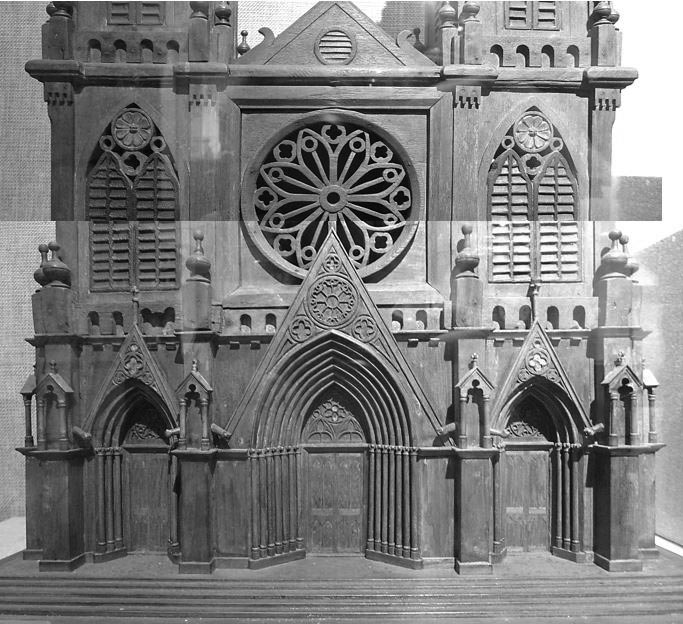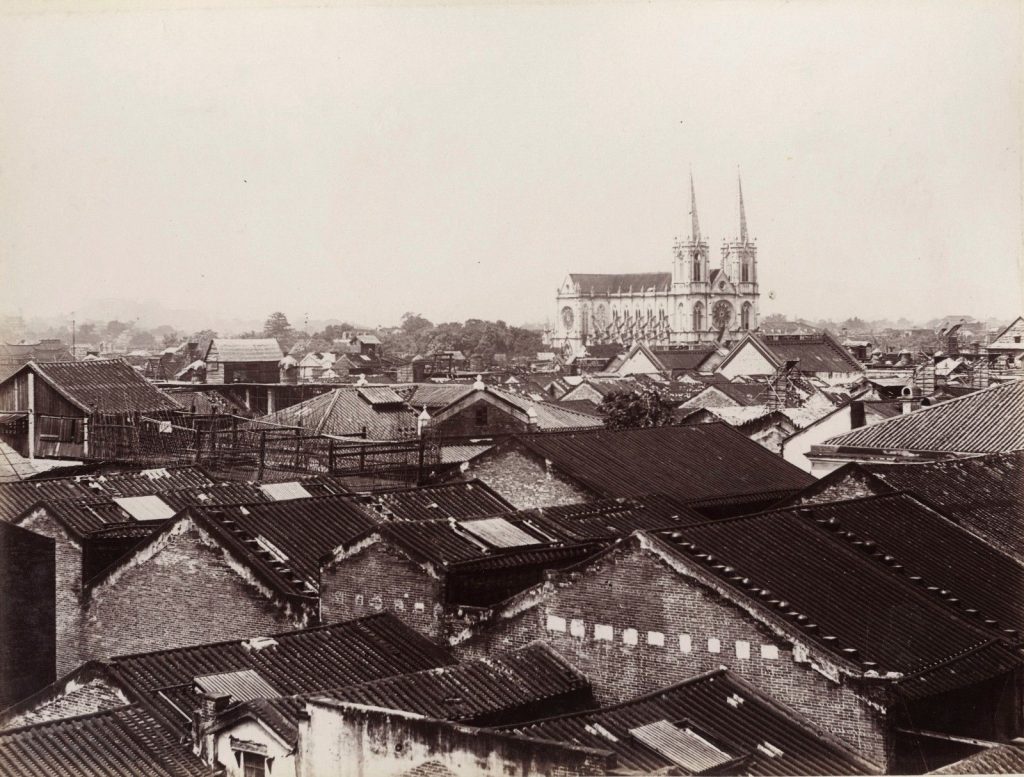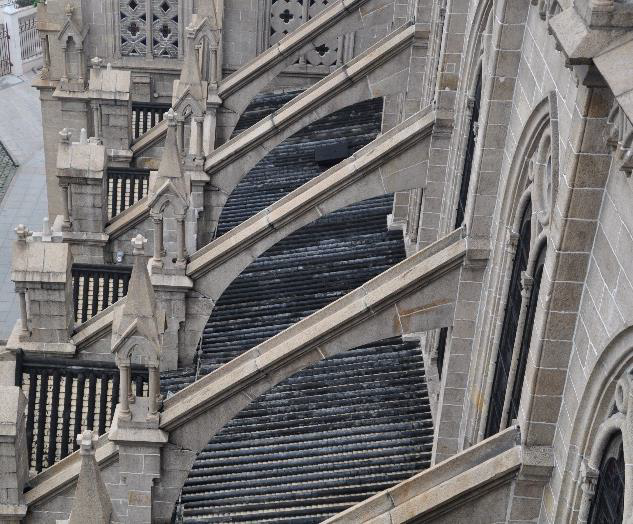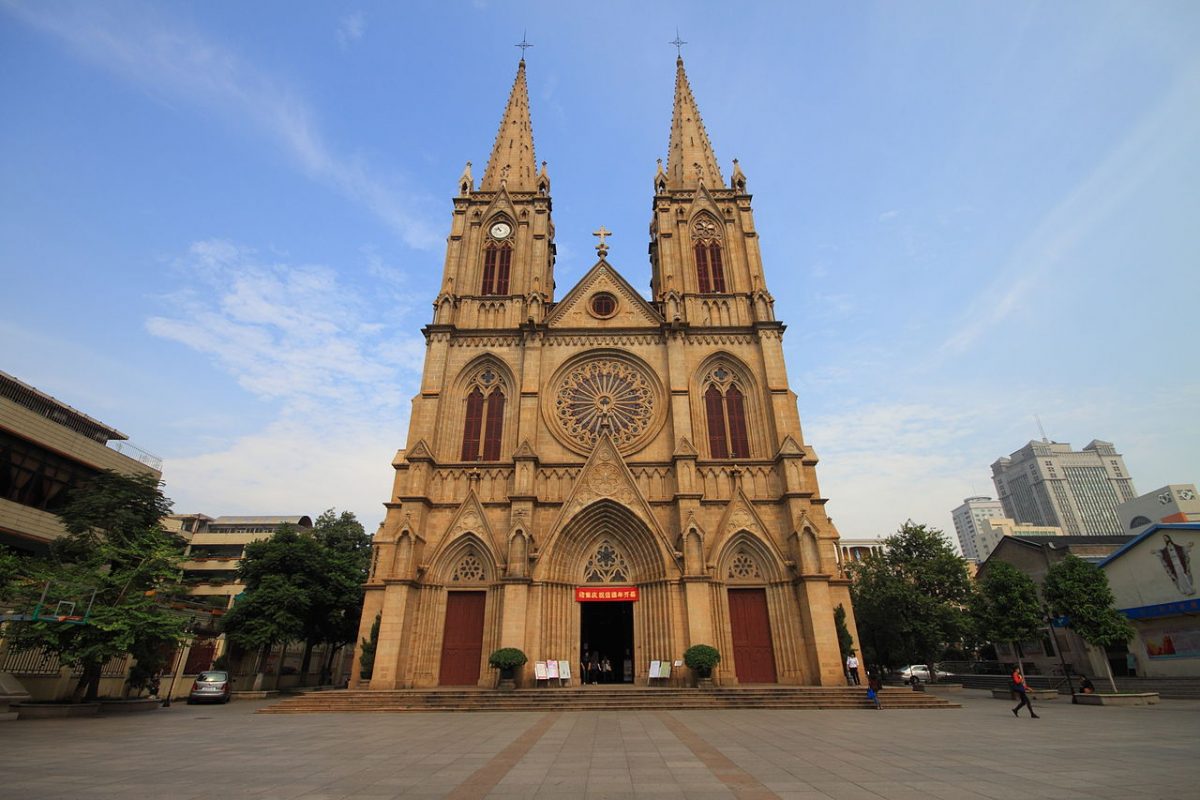A Culture Clash under Colonialism
With the signing of the unequal treaties between China and the Western powers at the end of the First Opium War, the number of missionaries entering China has dramatically increased and new Christian churches and chapels have emerged consequently1. The main Catholic exponents in China were French missionaries who chose a Gothic-revival style for most of the new constructions, and the Sacred Heart Cathedral was an important example of such style. With a ground plan of 78.70 meters long and 35 meters wide2, it is the largest Cathedral in Gothic style in China and Southeast Asia, and is one of the few churches in the world to be entirely constructed of granite, which is also known by the locals as the Stone House. Although it was designed by the French architects and constructed by the local Chinese workers, rather than a harmonious hybridization of the European architectural design and the Chinese building techniques, the construction of the Sacred Heart Cathedral in Guangzhou was more of a cultural clash resulted from colonialism that underwent a series of tremendous challenges and conflicts.
The acquisition of the construction site of the Sacred Heart Cathedral could be traced back to the religious persecutions during the Yongzheng Emperor (1723-1735). Christianity was officially banned in China by the Emperor in 1724, followed by the expulsion of foreign missionaries and confiscation of many church properties3. After the First Opium War, the Qing government was compelled to return the previously confiscated properties, but it was difficult to identify the original locations in Guangzhou. Therefore, the Paris Foreign Missions Society (Société des Missions Étrangères de Paris, MEP) were allowed to choose a piece of land in the city as compensation for all the confiscated and destroyed religious properties4. In 1858, Bishop Philippe François Zéphirin Guillemin (1814–1886) as the vicar apostolic of the MEP in Guangzhou claimed the original residence of the Viceroy of Guangdong and Guangxi Provinces as the site of the cathedral, which the residence was completely destroyed and Viceroy Ye Mingchen was imprisoned by the British.
However, after the claim of land, the local government remained reluctant to release the property to the MEP until an agreement was signed in 1861. It was in accordance with the Sino-French Treaty of Tianjin (1858) which allowed French citizens to construct buildings within treaty ports and forced the former confiscated properties to be returned to local Catholics5. Signing the agreement was decisive to end the entanglements over the ownership of land between the local Chinese government and the MEP. With financial support from Napoleon III and donations from French Catholics, Guillemin oversaw the project, and the construction of the foundation finally began on June 28, 1861.

With the completion of the foundation in 1863, the construction of the major structure was facing unprecedented challenges. Mostly due to its all-granite structure and the lack of machinery, the cathedral had to be built by hand by the local Chinese workers, who were completely alienated and hostile to European architecture, not to mention had any experience of building one. A wooden model of the cathedral was sent from Paris by the sculptor Victor Paynet but was not sufficient at all (Fig. 1). Communication was another major issue when the French designers and the Chinese builders did not speak each other’s language. Due to the distancing between the architects and labor, the construction progress was slow during the first few years and it took 25 years to complete the entire structure (1863-88). The French eventually employed a Chinese stone carver named Cai Xiao as the foreman. Cai was skilled in building stone houses in his hometown and understood the principles of Gothic structure and decoration. He was able to develop unique and creative methods of stone building construction with limited machinery supports, which enabled him to carry the project to a successful conclusion6.
Besides the technical difficulties of the construction, at the time the cathedral was constructed, most of the local Cantonese were xenophobic due to the suffering during the First and the Second Opium War. In addition, the buildings in Guangdong were no more than two stories high, and with the erection of such magnificent structure in public space, the architecture “reinforced the ‘feudal and colonial’ character of Catholic missions in China and exacerbated xenophobic feelings.”7 Tensions were built up between the two sides and conflicts often arose.
Because of the huge difference between the Chinese and the Western culture, the erection of a Gothic Cathedral raised a lot of misunderstanding from the Chinese for aesthetic, symbolic and political reasons. The style and form of Gothic were unknown and foreign, and thus the local population believed that it was imperialist and particularly humiliating since the cathedral was located at the original site of the former Chinese Viceroy’s palace. Stone, masonry, Gothic archies and traceries were unfamiliar to Guangzhou, which was originally a city of timber and bricks. Thus, the cathedral was called “stone house” or the “stone house of the foreign devils” 8. Due to the site chosen by the cathedral, the construction of its affiliated schools and hospitals required the demolition of the surrounding houses and the local residents were relocated. The series of foreign-constructed buildings created an unusual scene for the city, and according to the principles of fengshui, the pointed spires of the cathedral would bring misfortune and disasters to the city and its people which resulted in more suspicious and hatred towards the church.

The erection of the Sacred Heart Cathedral in Guangzhou allowed Christianity to be physically presented in public at the local Chinese community, and it was inseparable from both the European architects who designed the building plan and the local Chinese builders. Although a culture clash was inevitable when two different building traditions encountered under colonialism, the designers and missionaries gained experience by studying and adapting their designs into the local environment, and the local craftsmen also learned new forms and techniques during the construction of the church. The exchange of knowledge and building techniques during a cultural clash is an important aspect in architectural history that is worth acknowledgement.

Endnotes
- Guillen-Nuñez, César. “Rising from the Ashes: The Gothic Revival and the Architecture of the “New” Society of Jesus in China and Macau.” In Jesuit Survival and Restoration, 284
- Jean-Paul Wiest, “The Building of the Cathedral of Canton: Political, Cultural and Religious Clashes,” Religion and Culture, Past Approaches Present Globalisation Future Challenges (Macao: Macau Ricci Institute, 2004), 250
- Xiang, Hongyan. “Building an Ecclesiastical Real Estate Empire in Late Imperial China.” The Catholic Historical Review 104, no. 4 (2019): 636-658. doi:10.1353/cat.2019.0014. 637
- Guillen-Nuñez, César. “Rising from the Ashes: The Gothic Revival and the Architecture of the “New” Society of Jesus in China and Macau.” In Jesuit Survival and Restoration, 293
- Xiang, Hongyan. “Building an Ecclesiastical Real Estate Empire in Late Imperial China.” The Catholic Historical Review 104, no. 4 (2019): 636-658. doi:10.1353/cat.2019.0014. 643
- Coomans, Thomas & Xu, Yitao. (2015). Gothic Churches in Early 20th-Century China: Adapting Western Building Techniques to Chinese Construction Tradition.
- Coomans, Thomas & Xu, Yitao. (2015). Gothic Churches in Early 20th-Century China: Adapting Western Building Techniques to Chinese Construction Tradition.
- Coomans, Thomas. “East Meets West on the Construction Site. Churches in China, 1840s-1930s.” Construction History 33, no. 2 (2018): 63-84. Accessed February 16, 2021. doi:10.2307/26562566. 69-70
Bibliography
Coomans, Thomas. “East Meets West on the Construction Site. Churches in China, 1840s-1930s.” Construction History 33, no. 2 (2018): 63-84. Accessed February 16, 2021. doi:10.2307/26562566.
Coomans, Thomas & Xu, Yitao. (2015). Gothic Churches in Early 20th-Century China: Adapting Western Building Techniques to Chinese Construction Tradition.
Guillen-Nuñez, César. “Rising from the Ashes: The Gothic Revival and the Architecture of the “New” Society of Jesus in China and Macau.” In Jesuit Survival and Restoration, 178-298. Brill, 2014.
Jean-Paul Wiest, “The Building of the Cathedral of Canton: Political, Cultural and Religious Clashes,” Religion and Culture, Past Approaches Present Globalisation Future Challenges (Macao: Macau Ricci Institute, 2004), 231-252
Xiang, Hongyan. “Building an Ecclesiastical Real Estate Empire in Late Imperial China.” The Catholic Historical Review 104, no. 4 (2019): 636-658. doi:10.1353/cat.2019.0014.
Images
Fig. 1: Detail of the wooden model sent from Paris in 1860, conserved at the Guangzhou City Museum (photos THOC 2017).
Fig. 2: Sacred Heart Cathedral Guangzhou, c1880. Accessed Feb 16, 2021 (Lai Afong, 1880) https://commons.wikimedia.org/wiki/File:Lai_Afong,_Sacred_Heart_Cathedral_Guangzhou,_c1880.JPG
Fig. 3: Stone masonry and Gothic flying buttresses, Sacred Heart Sacred Heart cathedral of Guangzhou (Thomas Coomans, March 2012)
